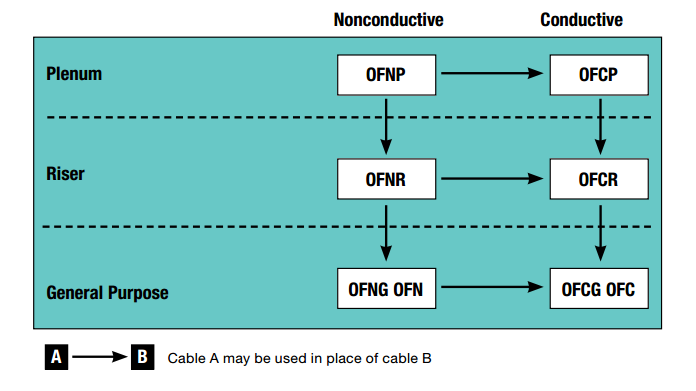Outer jacket types
Fiber cable outer jackets can be classified into several types in terms of different materials. These materials have different characteristics and use that depends on the application’s setting. The list below shows the most popular types of outer jacket materials and its uses.
| Material | Characteristics and uses |
|---|---|
| PVC (Polyvinylchloride) | Most commonly used material for outer jacket. It is low cost, strong, flexible, fire resistant and can be used in many applications. |
| PE (Polyethylene) | Very good electrical properties while maintaining high insulation. PE cables may be firm and solid but are more flexible. |
| PVDF (Polyvinyl Difluoride) | Has more flame-resistant properties than the PE cable and primarily used for plenum areas. |
| PUR (Polyurethane) | PUR is very flexible and scratch resistant that is mainly used in low-temperature environments. |
| LSZH (Low Smoke Zero Halogen) | LSZH is less toxic than PVC. It has a flame-retardant outer cover that doesn’t produce halogen when heated. Mainly used in confined installations. |
The National Electrical Code (NEC) has a classification system for optical fiber cables. These requirements specify how the fiber cables will behave in case of fire conditions and categorize depending on its application for these different areas.
Usage areas
| Area | Description |
|---|---|
| Plenum Area | Space used to move air to workspaces for the purpose of ventilation or to form air flow for an air distribution system. |
| Riser Area | Floor openings, tubes, or channels that run upwards over one or more floors. Riser cable is planned for use in upright shafts that run between floors. |
| General-Purpose Area | All other areas that are not plenum or riser on the same space or floor. |
Conductive vs. Non-conductive
Nonconductive cables contain nothing that can conduct electricity, so will not accidentally energize or be energized even when closely associated with electrical conductors.
Conductive cables contain noncurrent-carrying conductive members such as metallic strength members, metallic vapor barriers and metallic armor or sheath.
Fire rating levels
There are four levels of fire resistance for fiber cables and each level has two divisions which are the conductive and non-conductive cables. The higher rating cable is backward compatible to the lower rating cable and can be substituted while the lower rating cables can’t be used in place for the higher ratings.
| Marking | Decode | Description |
|---|---|---|
| OFNP/OFCP | Optical Fiber Nonconductive Plenum / Optical Fiber Conductive Plenum | OFNP and OFCP cables as the name implies are used for plenum areas and have resistance to fire and smoke. |
| OFNR/OFCR | Optical Fiber Nonconductive Riser / Optical Fiber Conductive Riser | Are used for the riser areas. These cables must prevent the fire from one floor to another. |
| OFNG/OFCG | Optical Fiber Nonconductive General-Purpose / Optical Fiber Conductive General-Purpose | These cables must not spread the fire for more than 4 feet, 11 inches. |
| OFN/OFC | Optical Fiber Nonconductive / Optical Fiber Conductive | To get this cable rating, the flame shall not infiltrate floors or ceilings and the cables are also used for general purpose areas. |

Comparison between OFNR and LSZH cables
These two cables are not the same type with just a different term. Failure to properly understand these classifications may lead to unfortunate accidents.
To summarize, OFNR cables are used for riser applications. It is non-conductive and is resistant to oxidation and degradation. It cannot be used to plenum areas but OFNP cables are compatible to rise applications. If you want to use it in a building, the structure must have a confined ventilation system and fire exits.
LSZH in comparison are made of special flame-resistant coating, and outstanding fire protection features such as low smoke, toxicity corrosion. LSZH cable jacketing are made of thermoplastic or thermoset compounds that produce little smoke and no halogen in case of fire.





